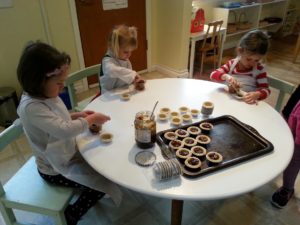“The essential thing is to arouse such an interest that it engages the child’s whole personality.”
Maria Montessori
The two classrooms at Shawnigan Lake Montessori provide stimulating, child-centred environments in which children can freely explore and interact with the educational materials. This freedom to touch and experience contributes to maintaining the child’s natural joy of discovery and growth and encourages a lifelong love of learning. Each child is also given individual teaching and shown how to use the environment to his or her best advantage.
When physical, mental, spiritual, and emotional needs are met, children experience a drive to play, work, learn, and create with enthusiasm. They exhibit a desire to teach, help, and care for others and for their environment. The children are given the freedom to develop naturally and without pressure. With respectful love and care for each child’s individuality, they are led towards independence and self-control.
The high level of academic achievement so common in Montessori schools is a natural outcome of experience in such a supportive environment. The Montessori Method of education serves the needs of children of all levels of mental and physical ability as they live and learn in a natural, mixed-age group.
Step 1 – School Visit and Meeting
This initial meeting provides an opportunity to look around the preschool and to explore the parent’s and the school’s needs and expectations in order to help ensure a good fit for the child. Typically this takes about 1 hour.
or call 250-743-6279
For more information view our enrollment page.
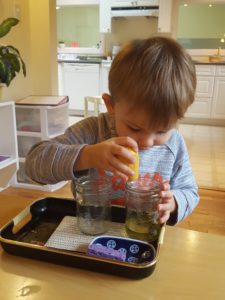 Through using the practical life materials the child develops the self-confidence, control and concentration essential for mastery of the other more advanced areas of a Montessori class.
Through using the practical life materials the child develops the self-confidence, control and concentration essential for mastery of the other more advanced areas of a Montessori class.
Children will be naturally drawn to this area of the room because these materials are most familiar to them, containing objects and materials that are normally encountered in the everyday living experiences of the children’s culture.
The exercises of Practical Life are the very heart of Montessori education. As children wash tables, pour liquids, polish silver, sweep and dust, they are developing the inner aptitudes of calmness, order, concentration, coordination, as well as refining their fine motor skills. At the same time, through the process of learning to meet their own needs, learning to take care of the classroom environment, and through the experience of helping others, children in the Montessori classrooms begin to develop independence, self-confidence, and self-respect.
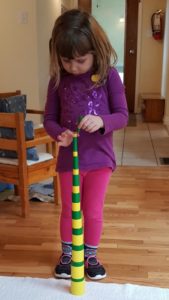
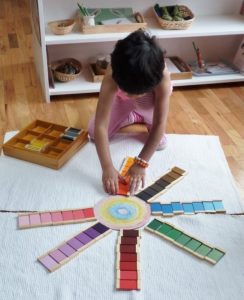 Maria Montessori discovered that children understand the world, through all their senses, and that only by making use of this knowledge can their understanding be developed to its fullest potential.
Maria Montessori discovered that children understand the world, through all their senses, and that only by making use of this knowledge can their understanding be developed to its fullest potential.
The primary purpose of the sensorial activities is to help the child in his/her effort to sort out the many and varied impressions received by the senses. The materials are specifically designed to develop, order, broaden and refine sense perception. The sensorial materials help the child to become aware of detail by isolating one defining quality, such as colour, weight, shape, texture, size, sound and smell.
The sensorial activities also provide the child with basic skills needed for mathematics work, including, calculation of amount or degree, exactness in perception and dexterity, discrimination among similarities, repetition, set recognition and recognition of progression in a series. Most of the sensorial materials provide the child with experiences in more than one of these skills.
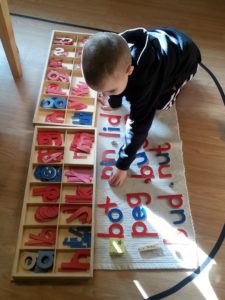 Language learning occurs most profoundly in the moment-to-moment life of interactions within the classroom.
Language learning occurs most profoundly in the moment-to-moment life of interactions within the classroom.
Children learn to listen, speak, and later to write and read. A balanced environment, one that is open yet not chaotic, is the most conducive to language learning. The children are encouraged to express themselves by relating their own experiences as well as songs and poetry. Story-telling and reading is an important part of each day’s activities.
Language activities include opportunities for young children to expand vocabulary, listen attentively to phonetic sounds, rhyme and look carefully to find likenesses and differences among objects and pictures.
Montessori’s sandpaper letters and movable phonetic alphabet enable children to learn the phonetic sounds of letters, whilst acquiring a sensorial awareness of letter formation. The carefully stepped phonetic reading program allows children to naturally progress towards literacy. Use of the Metal Insets, makes it possible for the child to control a writing instrument. Reading and spelling are absorbed naturally, giving a sound phonic foundation.
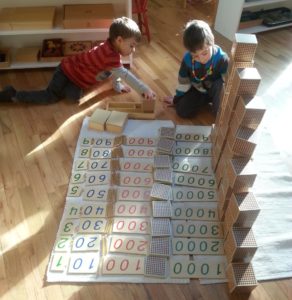 The child in the Montessori classroom is introduced to the required skills for mathematics by many aspects of both the practical life activities and the sensorial activities.
The child in the Montessori classroom is introduced to the required skills for mathematics by many aspects of both the practical life activities and the sensorial activities.
These Montessori materials form the foundation, in preparing the child for the abstract world of numbers. Montessori students use hands-on learning materials that make abstract concepts clear and concrete. This approach to learning offers a clear and logical strategy for helping children understand and develop a sound foundation in mathematics and geometry.
Mathematics activities are organized into five groups: introduction to numbers, introduction to the Decimal System, introduction to tens, teens and counting, arithmetic tables, and abstraction. In small sequential steps, each learner develops a mathematical mind at his or her own pace.
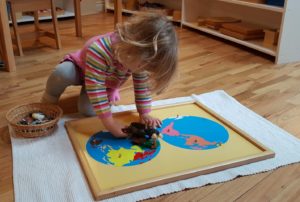 The Montessori classrooms offer many opportunities for the child to expand their knowledge of the world as they are motivated by their spontaneous interest and curiosity.
The Montessori classrooms offer many opportunities for the child to expand their knowledge of the world as they are motivated by their spontaneous interest and curiosity.
Following children’s natural interest in the world around them, biology, geography and history are introduced through the seasons, experiments, project work, timelines and lifecycles of animals and the children themselves. Stories of pre-history and recent history give a sense of the concept of time.
Celebrating festivals from countries around the world and looking at the children who live there helps to bring far away cultures closer to home. Observing nature and its changes, growing plants and creating nature tables brings the world outside into the classroom.
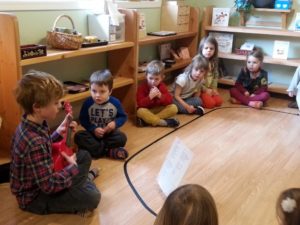 Music, movement and singing are part of the daily life of the classroom, with opportunities to listen and be involved in creating music. Classical music greets the children in the morning, setting a quiet peaceful tone to the start of their day. Circle times include singing, movement games and often the opportunity to hear others playing musical instruments.
Music, movement and singing are part of the daily life of the classroom, with opportunities to listen and be involved in creating music. Classical music greets the children in the morning, setting a quiet peaceful tone to the start of their day. Circle times include singing, movement games and often the opportunity to hear others playing musical instruments.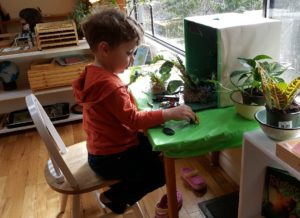 The ever changing nature table provides an introduction to life sciences, whether it is the Amazon rain forest or a spring exploration, hands on learning directly engages the children’s natural sense of awe and wonder.
The ever changing nature table provides an introduction to life sciences, whether it is the Amazon rain forest or a spring exploration, hands on learning directly engages the children’s natural sense of awe and wonder.
Different themes in the classroom are developed because of children’s curiosity; studying insects and watching caterpillars transform into butterflies, or looking at the universe around them and investigating our solar system all help to draw children into the amazing world we live in.
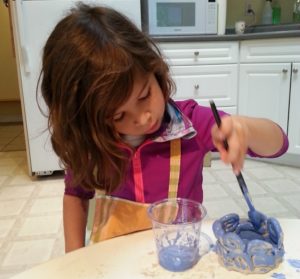 Children are naturally drawn towards creating art, and there are a wide and varied range of materials available for individual exploration and discovery.
Children are naturally drawn towards creating art, and there are a wide and varied range of materials available for individual exploration and discovery.
There are also opportunities to work with other mediums at different times of the year such as clay, fabric and natural materials. Special crafts and activities are available as part of exploring different topics or as part of seasonal or cultural celebrations.
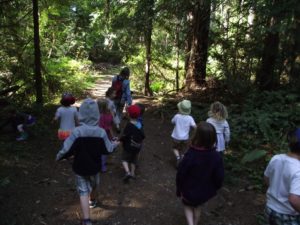 Shawnigan Lake Montessori is located on the beautiful campus of Shawnigan Lake School and we are fortunate to enjoy the use of the school grounds for regular field trips and hikes. Each day the children spend time outside playing in the gardens or forest surrounding the preschool with opportunities for natural play, gardening, watering and digging in the sand box, all of which develops friendships and social skills as well as co-ordination and strength.
Shawnigan Lake Montessori is located on the beautiful campus of Shawnigan Lake School and we are fortunate to enjoy the use of the school grounds for regular field trips and hikes. Each day the children spend time outside playing in the gardens or forest surrounding the preschool with opportunities for natural play, gardening, watering and digging in the sand box, all of which develops friendships and social skills as well as co-ordination and strength.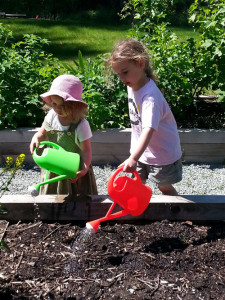 The natural outside environment is a part of the classroom learning environment; beans and seeds raised inside are then planted and cared for outside, seasonal changes seen outside are used as learning opportunities and further explored with exercises and activities in the classroom. Expanding children’s awareness of the natural world around them helps them to understand, respect and want to take care of living things.
The natural outside environment is a part of the classroom learning environment; beans and seeds raised inside are then planted and cared for outside, seasonal changes seen outside are used as learning opportunities and further explored with exercises and activities in the classroom. Expanding children’s awareness of the natural world around them helps them to understand, respect and want to take care of living things.Having a kitchen in the preschool means that cooking for celebrations or just for fun becomes a natural part of the daily rhythm of the classroom.
There are opportunities to explore yoga, dance and music, visitors bring a variety of experiences such as a new baby, or a new puppy, visits from chickens or grandparents from overseas!

